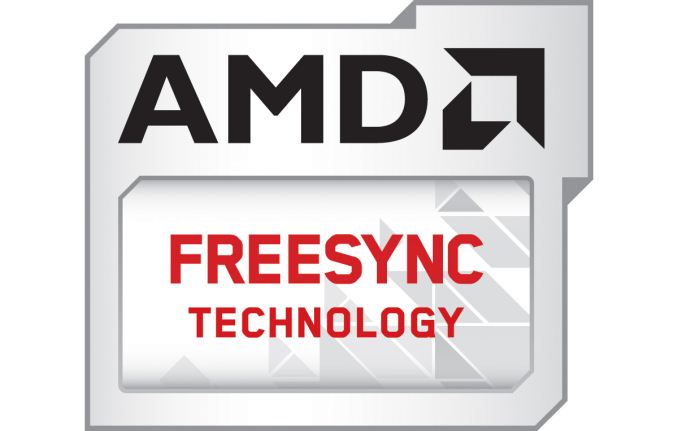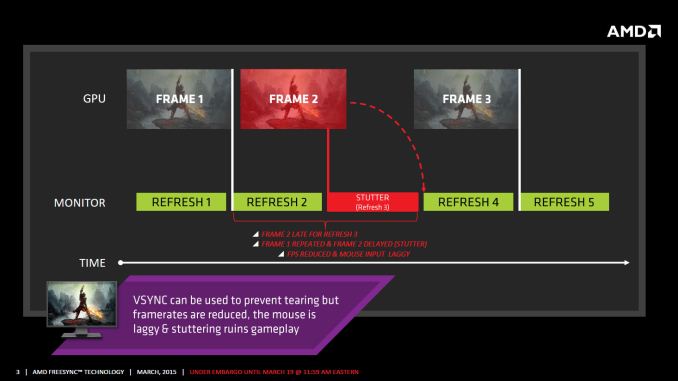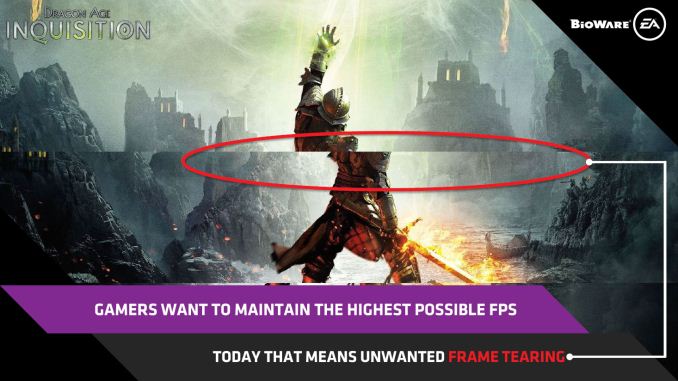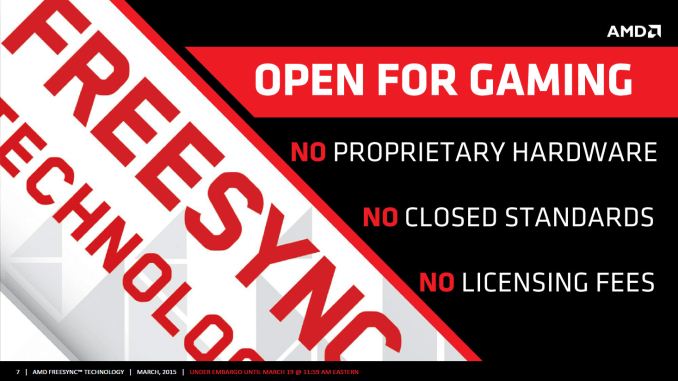The AMD FreeSync Review
by Jarred Walton on March 19, 2015 12:00 PM EST
Introduction to FreeSync and Adaptive Sync
The first time anyone talked about adaptive refresh rates for monitors – specifically applying the technique to gaming – was when NVIDIA demoed G-SYNC back in October 2013. The idea seemed so logical that I had to wonder why no one had tried to do it before. Certainly there are hurdles to overcome, e.g. what to do when the frame rate is too low, or too high; getting a panel that can handle adaptive refresh rates; supporting the feature in the graphics drivers. Still, it was an idea that made a lot of sense.
The impetus behind adaptive refresh is to overcome visual artifacts and stutter cause by the normal way of updating the screen. Briefly, the display is updated with new content from the graphics card at set intervals, typically 60 times per second. While that’s fine for normal applications, when it comes to games there are often cases where a new frame isn’t ready in time, causing a stall or stutter in rendering. Alternatively, the screen can be updated as soon as a new frame is ready, but that often results in tearing – where one part of the screen has the previous frame on top and the bottom part has the next frame (or frames in some cases).
Neither input lag/stutter nor image tearing are desirable, so NVIDIA set about creating a solution: G-SYNC. Perhaps the most difficult aspect for NVIDIA wasn’t creating the core technology but rather getting display partners to create and sell what would ultimately be a niche product – G-SYNC requires an NVIDIA GPU, so that rules out a large chunk of the market. Not surprisingly, the result was that G-SYNC took a bit of time to reach the market as a mature solution, with the first displays that supported the feature requiring modification by the end user.
Over the past year we’ve seen more G-SYNC displays ship that no longer require user modification, which is great, but pricing of the displays so far has been quite high. At present the least expensive G-SYNC displays are 1080p144 models that start at $450; similar displays without G-SYNC cost about $200 less. Higher spec displays like the 1440p144 ASUS ROG Swift cost $759 compared to other WQHD displays (albeit not 120/144Hz capable) that start at less than $400. And finally, 4Kp60 displays without G-SYNC cost $400-$500 whereas the 4Kp60 Acer XB280HK will set you back $750.
When AMD demonstrated their alternative adaptive refresh rate technology and cleverly called it FreeSync, it was a clear jab at the added cost of G-SYNC displays. As with G-SYNC, it has taken some time from the initial announcement to actual shipping hardware, but AMD has worked with the VESA group to implement FreeSync as an open standard that’s now part of DisplayPort 1.2a, and they aren’t getting any royalties from the technology. That’s the “Free” part of FreeSync, and while it doesn’t necessarily guarantee that FreeSync enabled displays will cost the same as non-FreeSync displays, the initial pricing looks quite promising.
There may be some additional costs associated with making a FreeSync display, though mostly these costs come in the way of using higher quality components. The major scaler companies – Realtek, Novatek, and MStar – have all built FreeSync (DisplayPort Adaptive Sync) into their latest products, and since most displays require a scaler anyway there’s no significant price increase. But if you compare a FreeSync 1440p144 display to a “normal” 1440p60 display of similar quality, the support for higher refresh rates inherently increases the price. So let’s look at what’s officially announced right now before we continue.













350 Comments
View All Comments
silverblue - Saturday, March 21, 2015 - link
I can certainly let you off most of those, but third party activities shouldn't count, so you can subtract 6 and 12. Additionally, 13 can be picked apart as the 295X2 showed that AMD can present a high quality cooler, and because I believe lumping the aesthetic qualities of a cooler in with heat and noise is a partial falsehood (admit it - you WILL have been thinking of metal versus plastic shrouds). I also don't agree with you on 11; at least, not if you move back past the 2XX generation as AMD had more aggressive bundles back then. 8 is subjective but NVIDIA usually gets the nod here.Also, some of your earlier items are proprietary tech, to which I could always tease you about as it's not as if they couldn't license any of this out. ;)
I'll hand it to you and credit you with your dozen.
chizow - Saturday, March 21, 2015 - link
And I thank you for not doing the typical dismissive approach of "Oh I don't care about those features" that some on these forums might respond with.I would still disagree on 6 and 12 though, ultimately they are still a part of Nvidia's ecosystem and end-user experience, and in many cases, Nvidia affords them the tools and support to enable and offer these value-add features. 3rd party tools for example, they specifically take advantage of Nvidia's NVAPI to access hardware features via driver and Nvidia's very transparent XML settings to manipulate AA/SLI profile data. Similarly, every feature EVGA offers to end users has to be worth their effort and backed by Nvidia to make business sense for them.
And 13, I would absolutely disagree on that one. I mean we see the culmination of Nvidia's cooling technology, the Titan NVTTM cooler, which is awesome. Having to resort to a triple slot water cooled solution for a high-end graphics card is terrible precedent imo and a huge barrier to entry for many, as you need additional case mounting and clearance which could be a problem if you already have a CPU CLC as many do. But that's just my opinion.
AMD did make a good effort with their Gaming Evolved bundles and certainly offered better than Nvidia for a brief period, but its pretty clear their marketing dollars dried up around the same time they cut that BF4 Mantle deal and their current financial situation hasn't allowed them to offer anything compelling since. But I stand by that bulletpoint, Nvidia typically offers the more relevant and attractive game bundle at any given time.
One last point in favor of Nvidia, is Optimus. I don't use it at home as I have no interest in "gaming" laptops, but it is a huge benefit there. We do have them on powerful laptops at work however, and the ability to "elevate" an application to the Nvidia dGPU on command is a huge benefit there as well.
anubis44 - Tuesday, March 24, 2015 - link
@chizow:But hey kids, remember, after reading this 16 point PowerPoint presentation where he points out the superiority of nVidia using detailed arguments like "G-Sync" and "GRID" as strengths, chizow DOES NOT WORK FOR nVidia! He is not sitting in the marketing department in Santa Clara, California, with a group of other marketing mandarins running around, grabbing factoids for him to type in as responses to chat forums. No way!
Repeat after me, 'chizow does NOT work for nVidia.' He's just an ordinary, everyday psychopath who spends 18 hours a day at keyboard responding to every single criticism of nVidia, no matter how trivial. But he does NOT work for nVidia! Perish the thought! He just does it out of his undying love for the green goblin.
chizow - Tuesday, March 24, 2015 - link
But hey remember AMD fantards, there's no reason that the overwhelming majority of the market prefers Nvidia, those 16 things I listed don't actually mean anything if you prefer subpar product and don't demand better, and you continually choose to ignore the obvious one product supports more features and the other doesn't. But hey, just keep accepting subpar products and listen to AMD fanboys like anubis44, don't give in to the reality the rest of us all accept as fact.sr1030nx - Saturday, March 21, 2015 - link
Only if they were NVIDIA branded speaker cables 😉Darkito - Friday, March 20, 2015 - link
FalseDarkito - Friday, March 20, 2015 - link
False, it's indistinguishable "Within the supported refresh rate range" as per this review. What happens outside the VRR window however, and especially under it, is incredibly different. With G-sync, if you get 20 fps it'll actually duplicate frames and tune the monitor to 40Hz, which means smooth gaming at sub-30Hz refresh rates (well, as smooth as 20fps can be). With FreeSync, it'll just fall back to v-sync on or off, with all the stuttering or tearing that involves. That means that if your game ever falls below the VRR window on FreeSync, image quality falls apart dramatically. And according to PCPer, this isn't just something AMD can fix with a driver update because it requires the frame buffer and logic on the G-Sync module!http://www.pcper.com/reviews/Displays/AMD-FreeSync...
Take note that the LG panel tested actually has a VRR window lower bound of 48Hz, so image quality starts falling apart if you dip below 48fps, which is clearly unacceptable.
AdamW0611 - Sunday, March 22, 2015 - link
Yah just like R.I.P Direct X, Mantle will rule the day, now AMD is telling developers to ignore Mantle, Gsync is great, and for those of us who prefer drivers being updated the same day games are released will stick with Nvidia, while months later AMD users will be crying that games still don't work right for them.anubis44 - Tuesday, March 24, 2015 - link
Company of Heroes 2 worked like shit for nVidia users for months after release, while my Radeon 7950 was pulling more FPS than a Titan card. To this day, Radeons pull better, and smoother FPS than equivalently priced nVidia cards in this, my favourite game. The GTX970 is still behind the R9 290 today. Is that the 'same day' nVidia driver support you're referring to?chizow - Tuesday, March 24, 2015 - link
More BS from one of the biggest AMD fanboys on the planet, an AMD *CPU* fanboy nonetheless. CoH2 ran faster on Nvidia hardware from Day1, and also runs much faster on Intel CPUs, so yeah, as usual, you're running the slower hardware in your favorite game simply bc you're a huge AMD fanboy.http://www.techspot.com/review/689-company-of-hero...
http://www.anandtech.com/show/8526/nvidia-geforce-...